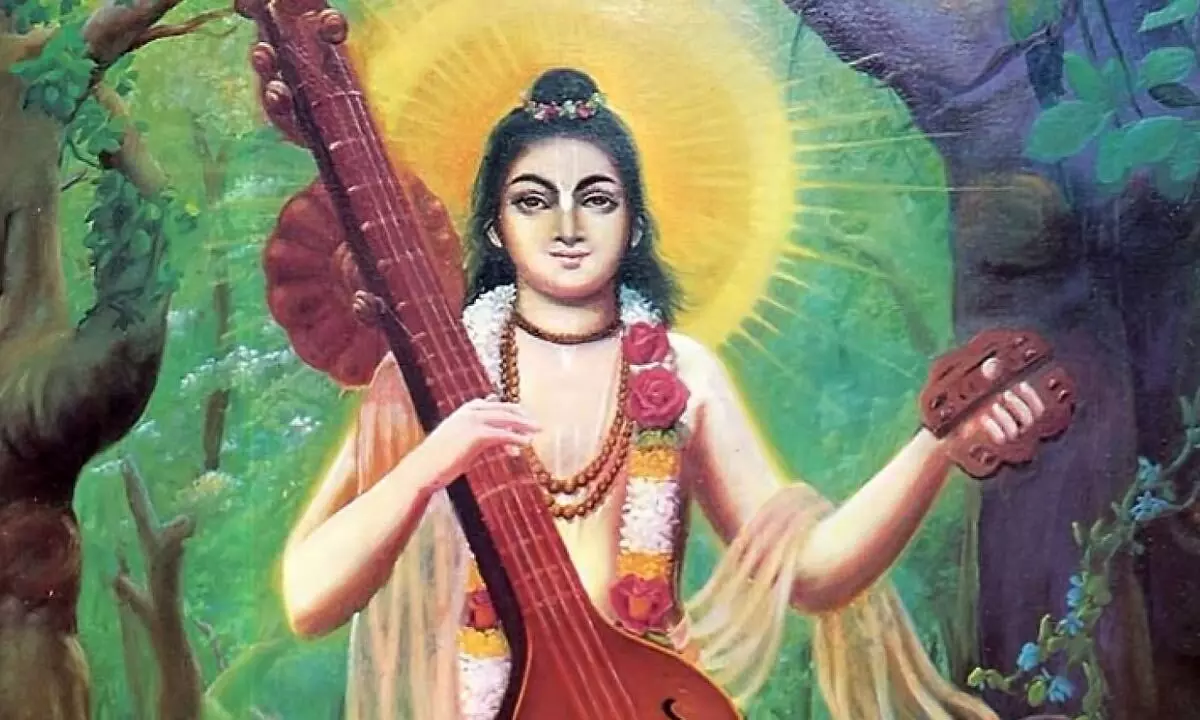Young Mother with Old Sons

Narada, the celestial sage, was on his rounds to several places on earth to see the happenings in the world.
Narada, the celestial sage, was on his rounds to several places on earth to see the happenings in the world. He visited many sacred places such as Kashi, Prayag, Kurukshetra, Godavari, Setubandha (Rama setu, which was a place of pilgrimage by then) and many others where he found large crowds visiting the shrines and offering prayers, but he did not find them truthful or righteous. Even as they came out of the shrines, they told lies and led licentious lives, all because of the advent of Kali yuga. Narada pensively moved along and saw a young woman who was anxiously trying to revive two sons who were unconscious, lying on the ground in a decrepit condition. The woman looked young, but her sons looked old.
Narada wondered and enquired as to who she was. She said, ‘I am Bhakti. These two are my sons Jnana (wisdom) and Vairagya (dispassion). They have grown old because of the evils of this yuga. I was born in Dravida land, grew up in Karnataka, Maharashtra and other places where I became weak, but I was fully revived when I reached Brindavan. My sons, however, continue to wither and look old.
To cut a long story short, Narada consulted other sages, Sanatkumara and others. They told him that the essence of Vedas is captured in Srimad Bhagavatam. Listening to it is a jnana yagna. It is the fruit of all Vedas, the nectar churned from the Vedas. After the withdrawal of the avatar as Krishna, the Lord entered this text in order to lead mankind to the path of jnana and liberation.
A miracle happened when Sanatkumara narrated Srimad Bhagavatam. Bhakti was transformed into a beautiful woman and the two sons were revived as young, healthy persons.
This is a story from Padma Purana, in which the psychology of bhakti is illustrated. Bhakti is figuratively called the consort of the Lord. It binds our mind to the idea of God. It should not be for the ten or fifteen minutes of puja or darshan in a temple, but it has to be a continuous awareness of the presence of a higher power which is guiding us. The ego of a person becomes thinner and thinner, and the mind will be able to listen and understand the scriptures. This paves the way for jnana and dispassion. For this reason, sage Vyasa described jnana and vairagya as the two sons of bhakti. There is spiritual health in a person or in a society where all the three are youthful. We see vigorous and competitive bhakti all around us. There is a mad rush at pilgrim places where we use all our influence to push others out and have darshan of Venkateswara or some other deity, but we rarely try to know the nature of the highest reality. Dipping ourselves in all holy waters may give spiritual merit but it binds us further in our ambition and greed for more.
Bhagavatam starts with the story of king Parikshit, who was under a curse that he would die within a week. Good sense prevails over him, and he wishes to seek liberation. Sage Suka relates to him the stories of the devotees of the Lord, who in this case, is visualised as Vishnu. The principle of bhakti is the same with any other form. The stories describe the quest of a variety of seekers, those who are in distress, such as Gajendra (the elephant) or Kunti, they may be others like Dhruva, seeking eminence, or there may be jnanis like Prahlada.
King Parikshit attains purity of mind and self-realisation by listening to the philosophical narrations. The curse of death does not bother, and he welcomes death, seeing it as a cessation of his earthly bondage. His curse gave a period of one week, but it applies to all humanity for whom the period is unknown.
(The writer is a former DGP, Andhra Pradesh)














